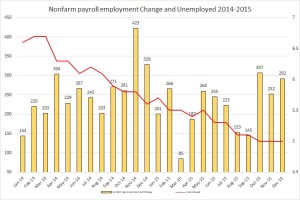The year started off with a lot of volatility mostly attributed to the selloffs of Chinese stocks. The growing concerns over what’s next for China pulled back up the demand for gold and silver. But then the NFP report came out on Friday –showing a gain of 292K in jobs, which was higher than expected – this brought back down gold and silver prices. Will this week entail additional gains for precious metals? Besides the NFP report and China’s woes that will keep resonating in the financial markets, among the main U.S. reports that will be release this week are: Retail sales, industrial production, PPI, consumer sentiment, and JOLTS. Let’s breakdown what’s next gold and silver for the week of January 11-15:
The recent NFP report was better than expected in terms of growth in jobs, but when it comes to wages – let’s just say it’s complicated. The annual growth in wages is around 2.5% — still in line with the past three months’ levels. But on a month-over-month basis, wages didn’t pick up. This doesn’t mean wages may not pick up again in the coming months, but it raises the question of whether we will see higher growth in wages moving forward.
After all, if the Fed subscribes to the whole idea behind long run vertical line Phillips curve and that the Non-Accelerating Inflation Rate of Unemployment or NAIRU, as explained by Larry Summers, is set at 5%. So any further stimulus when the natural rate of unemployment is at 5% — the current level – will only create higher inflation expectations without bringing down unemployment. Then this could suggest higher rates ahead – not a good sign for PM investors. The recent minutes of the FOMC didn’t offer much insight behind the last rate hike, but the Fed still seems convinced in raising rates several times in year. Summers, by the way, doesn’t believe that the right course of action only thinks that’s the model behind the Fed’s rate hike in December.
This week, the NFP report will continue to echoing in the markets and could keep driving down gold and silver prices, as it did back on Friday. The linear correlations between the surprise and bullion prices’ reactions are still strong and negative, which could shed some light behind the recent fall of PM prices.
Besides the NFP, the focus is likely to remain China and what’s next for the second largest economy. Anxiety in the markets and unrest in the Middle East over the dispute between Saudi Arabia and Iran are also developments that could push up the demand for gold and silver, which act as a long tail commodity in times of unrest in the markets. In the U.S. the main reports that will come out are retail sales, consumer sentiment, JOLTS, PPI and industrial production. The first two relate to consumer spending, the third addresses the progress of the labor market, the fourth is a proxy to inflation – albeit less important than PCE or CPI and the last one estimates production. If these reports show the U.S. continues to improve and the headline figures including retail sales and JOTLS reach or beat expectations, then they could pull back up the U.S. dollar and drive back down bullion prices.
ETFs and Fed’s future rate hikes
Based on the recent update by Fed-watch, the implied probability for a rate raise in March is down to 45%; and 66% in June 2016 – nearly 12pp lower than the previous week. By the end of the year, the market estimates the Fed’s cash rate will be, on average, 0.8% — this still implies a couple of hikes this year. If the U.S. labor market keeps showing progress, this could further raise this figure, which won’t behoove PM prices.
Following the high volatility in PM prices, ETFs holdings also shifted: By the end of last week, gold holding of the gold ETF SPDR Gold Trust (GLD) rose by 1.1%, week on week, to 649.59 tons of gold. While silver holdings for the silver ETF iShares Silver Trust (SLV) declined again by 0.5% to 316.36 million ounces.
Final point
Gold and silver – much like other commodities – had a turbulent week, which isn’t likely to fade away in the near term. Considering the week is starting off light on the news, markets are likely to continue to digest the NFP report along with speculating what’s next for China. If concerns over China continue to mount, it could, even if for a short term, help pull up PM prices. But if the focus will shift back to the U.S. and assuming the upcoming reports – mostly JOLTS and retail sales – don’t disappoint, then expect gold and silver to come back down as the U.S. dollar recovers.
For further reading see:

